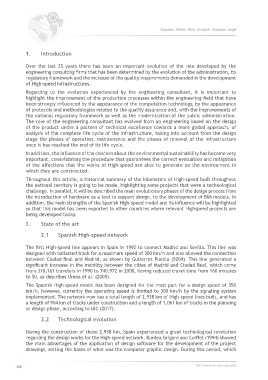Page 448 - 360.revista de Alta Velocidad - Nº 6
P. 448
Escobar, Adrián. Rico, Enrique . Escobar, Jorge
1. Introduction
Over the last 25 years there has been an important evolution of the role developed by the
engineering consulting firms that has been determined by the evolution of the administration, its
regulatory framework and the increase of the quality requirements demanded in the development
of High-speed Infrastructures.
Regarding to the evolution experienced by the engineering consultant, it is important to
highlight the improvement of the production processes within the engineering field that have
been strongly influenced by the appearance of the computation technology, by the appearance
of protocols and methodologies related to the quality assurance and, with the improvements of
the national regulatory framework as well as the modernization of the public administration.
The role of the engineering consultant has evolved from an engineering based on the design
of the product under a pattern of technical excellence towards a more global approach, of
analysis of the complete life cycle of the infrastructure, taking into account from the design
stage the phases of operation, maintenance and the phases of renewal of the infrastructure
once it has reached the end of its life cycle.
In addition, the influence of the concern about the environmental sustainability has become very
important, consolidating the procedure that guarantees the correct evaluation and mitigation
of the affections that the works of High-speed are able to generate on the environment in
which they are constructed.
Throughout this article, a historical summary of the kilometers of High-speed built throughout
the national territory is going to be made, highlighting some projects that were a technological
challenge. In parallel, it will be described the main evolutionary phases of the design process from
the introduction of hardware as a tool to support design, to the development of BIM models. In
addition, the main strengths of the Spanish High-speed model and its influence will be highlighted
so that this model has been exported to other countries where relevant Highspeed projects are
being developed today.
2. State of the art
2.1 Spanish High-speed network
The first High-speed line appears in Spain in 1992 to connect Madrid and Sevilla. This line was
designed with ballasted track for a maximum speed of 300 km/h and also allowed the connection
between Ciudad Real and Madrid, as shown by Gutierrez Puebla (2004). This line generated a
significant increase in the mobility between the cities of Madrid and Ciudad Real, which come
from 310,161 travelers in 1990 to 740,972 in 2000, having reduced travel time from 160 minutes
to 50, as describes Ureña et al. (2005).
The Spanish High-speed model has been designed for the most part for a design speed of 350
km/h, however, currently the operating speed is limited to 300 km/h by the signaling system
implemented. The network now has a total length of 2,938 km of High-speed lines built, and has
a length of 904 km of tracks under construction and a length of 1,061 km of tracks in the planning
or design phase, according to UIC (2017).
2.2 Technological evolution
During the construction of these 2,938 km, Spain experienced a great technological revolution
regarding the design works for the High-speed network. Burdea Grigore and Coiffet (1994) showed
the main advantages of the application of design software for the development of the project
drawings, setting the bases of what was the computer graphic design. During this period, which
446 360.revista de alta velocidad

